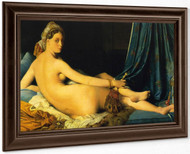Jean-Auguste-Dominique Ingres (French, 1780 - 1867)
Published by Elizabeth Goodman on 11th Jul 2019
Jean Auguste Dominique Ingres was one of the best artists in French history. Born on 29th August 1780, Ingres regarded himself as a painter of history. He was considered a neoclassical painter. When he died on 14th January 1867, his paintings and drawings were his foremost legacies until today. During his early days as a painter, he tried to depart from romantic style that dominated the art industry of his time. He regarded himself as the pioneer of the academic orthodoxy. Despite his great effort to establish orthodox paintings, many modern painters believe that the romantic spirit that prevailed in his time dominated him. However, many believe the Ingres paved the way for the emergence of modern arts.
Born in Montauban, France, Ingres was the first of the seven children born to his parents. His parents were Jean Marie Joseph Ingres and Anne Moulet. It is said that he derived his passion partly from his father who was described as an artist of all trades. This means that he was not specialized in any field; rather he has works in sculptor, amateur music, as well as decorative stonemason. His father gave him initial instructions about music and painting. This could be seen from the first drawings he ever produced, which was around the year 1789.
He however enrolled in formal education at Ecole Des Freres de l education. However, the French revolution that followed that disrupted his early education. In fact, he never had any other attempt at conventional education after the revolution, which forced schools to close in 1791.
However, he was tutored at Toulouse Academie Royale de Peinture, Sculpture and Architecture. The foremost painters like Jean Pierre Vigan a renowned sculptor, Jean Briant a famous landscape painter and Guillaume Joseph Roques one of the foremost neoclassical, instructed him. He was largely influenced by the veneration of Raphael by Roques. He was such brilliant as a trainee that he won various prizes in different subjects like life studies, antique and figure as well as the composition.
He later studied in Paris and under Jacques Louis David through scholarship. Here he studied for four years. Due to economic hardships because of the revolution, he worked in Paris and developed the contour style.
He made his first painting in 1802 of a woman portrait. It was clear that works of Raphael, John Flaxman as well as the Etruscan paintings, influenced his early works. He was selected as one of the state artists to produce the portrait of Napoleon Bonaparte at first consul. His paintings were exceptionally good.
He became engaged to Marie Anne Julie Forestier in 1806 and left for Rome thereafter against his wish to witness the opening of a new saloon that would display his work among other works. Ingres tried throughout his work to digress from the past, which earned him many criticisms from most of his contemporaries. Ingres always borrowed greatly from the past ideas and mixed it with contemporary styles. 19th century artists benefitted from his efforts. Because of the criticisms he faced in Paris, he refused to return to the city and this led to the end of his engagement.
In Rome, he continued with his trainings and sent paintings regularly to Paris. Some of the great paintings he sent to Paris include the Valpincon Bather, Oedipus, and the Sphinx. Others include François Marius Garnet, Madame Duvaucay, Madame Panckouche, Edme Francois, and Joseph Bochet and so on.
He later married to Madeleine Chapelle in 1813 and the marriage was a blessed one. She clearly understood and shared with him throughout the difficulties he encountered. He struggled until he got a government job in Rome. He tried to use every opportunity to establish himself as a painter of history. The opportunity came to him when he was contacted by the Catholic Church to produce a portrait of Jesus handing over key to Peter. He was not happy he was not allowed to display the work in Paris after producing it. He still managed to send some works for display in Paris. He later moved to Florence on the invitation of his friend Lorenzo Bartolini. The major work that pushed him into reckons was the Vow of Louis X111 which he finished and displayed in Paris. This brought him a lot of success leading to the award of major government paintings such as the Cross of Legion D Honneur by Charles X. He performed other paintings like Apotheosis of Homer and several others, which made him a national hero.
He got a professorship at the Ecole des Beaux Arts, but the death of his wife in 1849 devastated him and he has to give up most of his contracts. He surrendered all his work to his city of Montauban in France and resigned his professorship. At the age of 71, he married Delphine Ramel aged forty-three. He completed several works after that including the Apotheosis of Napoleon 1, as well as the Joan of Arc in 1853. He did other major works until he died of pneumonia in 1867.

